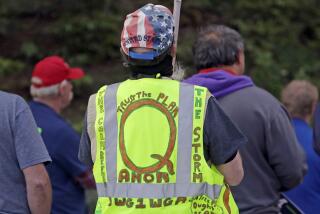The Evolution and Devolution of a âUtopianâ Self-Help Group
The saga of Synanon is a long, strange trip, as Rod Janzen shows us in âThe Rise and Fall of Synanon: A California Utopiaâ (Johns Hopkins University Press, $34.95, 320 pages), a particularly dark and disturbing permutation of the California Dream that started with an earnest effort at rescuing self-described âdope fiendsâ from their addictions and ended with a rattlesnake in the mailbox of one of its critics.
Synanon, as Janzen points out in his authoritative and highly readable study, was a spinoff of Alcoholics Anonymous. Its founder, Charles Dederich, was a disaffected AA member who was frustrated by its refusal to accept drug addicts during the â50s. So he set up his own operation in a condemned storefront in Venice--âSynanonâ is the name he chose because it âlooked good on the side of a truckâ--and he invented his own brand of encounter therapy called the Game, a sometimes-brutal ordeal of confession and confrontation that Janzen describes as âthe central unifying experience of all Synanon people.â
âThe Game is a big emotional dance, and itâs like a dream,â explained Dederich. âSome dreams are nightmares.â
Riding the wave of the counterculture in the mid-â60s, Synanon eventually attracted some 25,000 members, not only the âdope fiendsâ who were struggling with their addictions but also the fellow travelers who were called âSquaresâ (or, sometimes, âhonorary dope fiendsâ) and joined Synanon on a vague, utopian impulse. âThere is, indeed, a miracle on the beach at Santa Monica,â enthused Sen. Thomas Dodd of Connecticut, one of the many celebrities drawn into the orbit of Synanon.
The miracle of Synanon, of course, turned out to have a diabolical side. Ironically, as Janzen points out, one of the grievances that drove Dederich out of Alcoholics Anonymous was his discomfort with its âreligious underpinnings.â But Dederich himself slowly turned Synanon into a self-described church, and he served as its âcharismatic wizard-leader,â as Janzen puts it. To its critics, Synanon was now a dangerous cult.
Janzen considers all of the accusations and condemnations that were lodged against Synanon as it reinvented itself in the 1970s, including the investigative reporting that earned the Point Reyes Light newspaper a Pulitzer Prize. Among the more scandalous practices decreed by Dederich were mass vasectomies, mate-swapping, corporal punishment of both adults and children, and such bizarre incidents as the rattlesnake attack on attorney Paul Morantz and the hanging of a dog that belonged to a former president of Synanon.
But, despite such scandals, Janzen refuses to condemn the now-defunct group or its now-deceased founder, whose âlegacyâ also includes what he called âa vital moral sense vividly demonstrated by those who were once members.â Janzen, a professor of history and social sciences at Fresno Pacific University, puts Synanon squarely into âthe context of utopian ideology and practiceâ along with such strange bedfellows as the Puritans, the Shakers and the Latter-day Saints.
âSynanon was not simply a paranoid cult composed of the always compliant followers of a power-hungry founder, though there were times when things did get a bit crazy,â concludes Janzen. âInstead, it was an honest, evolving social experiment designed to maximize human potential in a chaotic postmodern world.â
Another dark chapter in recent history is given a human face in âA Very Dangerous Citizen: Abraham Lincoln Polonsky and the Hollywood Left,â by Paul Buhle and Dave Wagner (University of California Press, $27.50, 282 pages), an engaging and provocative account of a courageous writer who ultimately prevailed over the Hollywood blacklist of the McCarthy era.
Polonsky, described by Buhle and Wagner as a âfull-time radical romantic,â was among the most celebrated victims of the McCarthy era. He was blacklisted in 1951 when he refused to âname namesâ in testimony before the House Un-American Activities Committee, but he continued to work under a variety of pseudonyms, and he was ultimately rehabilitated by a new generation of movie-makers who admired both the courage of his convictions and the quality of his work.
âThe wry figure on the losing side of history in the second half of a disappointing century,â write the authors, âwas reaching out to those who would make politics and culture in the new millennium.â
âA Very Dangerous Citizenâ is as much about the politics and popular culture of America in the troubled years of the mid-20th century as it is about Polonsky himself, and yet the book is always rooted in both the life and work of this remarkable man. Indeed, the authors draw scenes and dialogue from Polonskyâs novels and scenarios as well as from the incidents of his life, using one to illuminate the other in surprising ways.
The authors insist, for instance, that Polonskyâs 1948 film noir classic, âForce of Evil,â can be seen as the ultimate embodiment of âtrue Polonskyan style,â a morality tale of betrayal that would take on new and haunting significance a few years later when people began betraying each other in Hollywood. âThis sense of political struggle touches everything in âForce of Evil,ââ write Buhle and Wagner, âfrom script to production and even to historical context.â
âIâm celebrating a clear conscience,â says one of the principal characters to his secretary.
âOh?â she responds with âa musical sarcasm.â âWhose?â
Born in the Bronx in 1911, he was taught by his free-thinking Jewish parents to embrace socialism and secular Yiddish culture. Young Polonsky was first exposed to the theatrical world when his father, who ran a drugstore, sent him to deliver makeup to the burlesque houses.
âHe learned important human lessons from talking to stage girls five to 15 years or more older than he,â they write. âFrom these women, unread in any philosophical work, he claims to have gained a philosophy of life and love.â
Polonsky was poring over Proust when his more radical classmates were studying Marx, as his biographers point out, but he eventually joined the ranks of both the Communist Party and the writers who headed to Hollywood in the â30s and â40s. âAs soon as I saw this magnificent nonsense going on, I said, âThis is the work for me,ââ Polonsky recalled. âI not only became an inmate, I wanted to run the asylum.â
Not exactly the sentiments of âa very dangerous citizen,â but thatâs how Polonsky was described by one of his interrogators at the McCarthy hearings, where he refused to answer questions and thus wrote himself onto the blacklist. Dangerous? âOnly to himself,â quipped his wife, Sylvia Polonsky.
*
West Words looks at books related to California and the West. Jonathan Kirsch can be reached at jkirsch@kirsch-mitchell.com.
More to Read
Sign up for our Book Club newsletter
Get the latest news, events and more from the Los Angeles Times Book Club, and help us get L.A. reading and talking.
You may occasionally receive promotional content from the Los Angeles Times.







